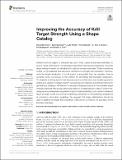Files in this item
Improving the accuracy of krill target strength using a shape catalog
Item metadata
| dc.contributor.author | Bairstow, Fiona Jay | |
| dc.contributor.author | Gastauer, Sven | |
| dc.contributor.author | Finley, Luke | |
| dc.contributor.author | Edwards, Tom | |
| dc.contributor.author | Brown, C Tom A | |
| dc.contributor.author | Kawaguchi, So | |
| dc.contributor.author | Cox, Martin | |
| dc.date.accessioned | 2021-04-07T10:30:03Z | |
| dc.date.available | 2021-04-07T10:30:03Z | |
| dc.date.issued | 2021-04-07 | |
| dc.identifier | 273171640 | |
| dc.identifier | 523db138-4215-44cc-be16-24f1cced1d65 | |
| dc.identifier | 000638238200001 | |
| dc.identifier | 85104668001 | |
| dc.identifier.citation | Bairstow , F J , Gastauer , S , Finley , L , Edwards , T , Brown , C T A , Kawaguchi , S & Cox , M 2021 , ' Improving the accuracy of krill target strength using a shape catalog ' , Frontiers in Marine Science , vol. 8 , 658384 . https://doi.org/10.3389/fmars.2021.658384 | en |
| dc.identifier.issn | 2296-7745 | |
| dc.identifier.other | ORCID: /0000-0002-4405-6677/work/92019549 | |
| dc.identifier.uri | https://hdl.handle.net/10023/21785 | |
| dc.description | FB was funded by an EPSRC studentship (grant code: EP/R513337/1). SG received financial support from the Gordon and Betty Moore Foundation. | en |
| dc.description.abstract | Antarctic krill are subject to precautionary catch limits, based on biomass estimates, to ensure human activities do not adversely impact their important ecological role. Accurate target strength models of individual krill underpin biomass estimates. These models are scaled using measured and estimated distributions of length and orientation. However, while the length distribution of a krill swarm is accessible from net samples, there is currently limited consensus on the method for estimating krill orientation distribution. This leads to a limiting factor in biomass calculations. In this work, we consider geometric shape as a variable in target strength calculations and describe a practical method for generating a catalog of krill shapes. A catalog of shapes produces a more variable target strength response than an equivalent population of a scaled generic shape. Furthermore, using a shape catalog has the greatest impact on backscattering cross-section (linearized target strength) where the dominant scattering mechanism is mie scattering, irrespective of orientation distribution weighting. We suggest that shape distributions should be used in addition to length and orientation distributions to improve the accuracy of krill biomass estimates. | |
| dc.format.extent | 14 | |
| dc.format.extent | 3064090 | |
| dc.language.iso | eng | |
| dc.relation.ispartof | Frontiers in Marine Science | en |
| dc.subject | Antarctic krill | en |
| dc.subject | Euphasia superba | en |
| dc.subject | Morphometrics | en |
| dc.subject | Target strength | en |
| dc.subject | Acoustic scattering | en |
| dc.subject | GC Oceanography | en |
| dc.subject | QH301 Biology | en |
| dc.subject | S Agriculture | en |
| dc.subject | DAS | en |
| dc.subject.lcc | GC | en |
| dc.subject.lcc | QH301 | en |
| dc.subject.lcc | S | en |
| dc.title | Improving the accuracy of krill target strength using a shape catalog | en |
| dc.type | Journal article | en |
| dc.contributor.institution | University of St Andrews. School of Physics and Astronomy | en |
| dc.contributor.institution | University of St Andrews. Centre for Biophotonics | en |
| dc.contributor.institution | University of St Andrews. Office of the Principal | en |
| dc.identifier.doi | 10.3389/fmars.2021.658384 | |
| dc.description.status | Peer reviewed | en |
This item appears in the following Collection(s)
Items in the St Andrews Research Repository are protected by copyright, with all rights reserved, unless otherwise indicated.

